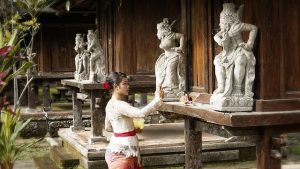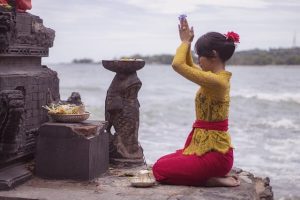桜の季節!都会よりもコンパクトな田舎が好き 〜インドネシア出身のお母さんの暮らし〜

都会よりもコンパクトな田舎が好き 〜インドネシア出身のお母さんの暮らし〜
寒い冬が終わり、春の訪れとともに桜の季節がやってきました。
国内では卒業式や入学式が行われ、新たな生活が始まる時期です。
そんな中、昨年出会ったインドネシア出身の女性についてお話ししたいと思います。
インドネシアから来日したお母さん
私は市内で、あるインドネシア人女性と知り合いました。
彼女は大学で「看護・介護」を学ぶために来日したそうです。
小柄で明るい性格の彼女には、なんと3人のお子さんがいます。
松山での暮らしについて尋ねると、「快適ですよ〜」と笑顔で答え、
「物価が安いのが助かりますね」とシングルマザーらしい
率直な意見を聞かせてくれました。
「子どもがまだ2歳から6歳だから、毎日戦争みたいです!」と
苦笑いしながらも、「少しずつ言うことを聞くようになって、
日本の生活にも慣れてきました。日本語も上達してきて嬉しいです」と続けました。
育児や生活は大変そうですが、彼女の表情には明るさがありました。
 イメージ
イメージ
インドネシアの暮らしと松山での違い
私は過去に何度かインドネシアを訪れたことがあるので、彼女といろいろな話をしました。
インドネシアは東南アジア最大の経済大国の一つで、人口は約2.5億人。
その多くが若年層で、特にジャカルタでは若者が目立ちます。
国の平均年齢も30歳前後で、活気に満ちています。
バリ島は世界的に有名なビーチリゾートで、美しい海や寺院が魅力的です。
私も訪れたことがありますが、観光地としての魅力はもちろん、
インドネシア全体が持つ独特の文化に惹かれました。
彼女の出身地について尋ねると、「ジャカルタのすぐ隣の街です。
でも、交通渋滞がひどくて大変なんですよ」と言いました。
「松山での生活はどうですか?」と聞くと、
「とても快適です!物価が安くて安心安全。子どもが夜一人で外に出ても
問題ないなんて、日本は本当に素晴らしいですね。
こんな町は世界的にも珍しいです」と、日本の治安の良さに驚いていました。
インドネシアと日本の文化の違い
私は「インドネシアは民主主義で、少し暑いけど住みやすいですね」と言うと、
彼女も「そうですね」と頷いていました。
また、「インドネシアは昔オランダの植民地だったので、
英語を話す人も多いですね」と話すと、彼女は少し不満げに
「オランダは良い国だけど、私たちは占領されていましたからね」と言いました。
詳しくは話しませんでしたが、歴史的背景についての複雑な思いがあるようでした。
 イメージ
イメージ
彼女の個性と日々の暮らし
その後、何度か彼女と会う機会がありました。
毎回、ヒジャブ(イスラム教の女性が頭に巻く布)の色が違うのが印象的でした。
「カラフルで素敵ですね!」と言うと、その日はピンクのヒジャブを
していた彼女は「実はピンクは好きじゃないんです!今日は服に合わせただけ。
本当はグリーンやブルーが好きなんです」と教えてくれました。
私はてっきりピンクが好きなのかと思っていたので、意外な答えに笑ってしまいました。
彼女は「礼拝は欠かさず、海外でもイスラムの教えを忠実に守っています」と
誇らしげに話しました。
また、イスラム教では食の戒律(ハラール)があり、
豚肉や豚由来の食品(ベーコンやゼラチンなど)は禁じられています。
「日本の食事で不便はないですか?」と聞くと、
「野菜も安いし、冷凍食品も充実しているので問題ないですよ」とのことでした。
田舎暮らしの魅力
彼女は「都会は好きじゃないんです。
子育てにはコンパクトなローカル都市が一番ですね」と話しました。
この言葉を聞いて、私も嬉しくなりました。
日本の地方都市が、異国から来た彼女にとっても安心できる場所に
なっていることが伝わってきたからです。
松山という町が、彼女やその子どもたちにとって温かい居場所であることを願っています。
続く!

I Prefer a Compact Countryside Over the City
~ Life of a Mother from Indonesia ~
As the cold winter comes to an end,
the arrival of spring brings the season of cherry blossoms.
In Japan, this is the time for graduation and entrance ceremonies,
marking the beginning of new journeys.
Amidst this, I would like to share the story of a woman
from Indonesia whom I met last year.
A Mother from Indonesia Who Moved to Japan
I met an Indonesian woman in my city.
She came to Japan to study “nursing and caregiving” at a university.
Despite her petite frame and cheerful personality,
she is a mother of three children.
When I asked her about life in Matsuyama,
she smiled and said, “It’s comfortable!”
She also shared her honest thoughts as a single mother,
saying, “The low cost of living is really helpful.”
She laughed wryly and added, “My kids are still between 2 and 6 years old,
so every day feels like a battle!”
However, she continued with a bright expression,
“They’re starting to listen to me little by little,
and we’re getting used to life in Japan.
Our Japanese is improving too, which makes our happy.”
Despite the challenges of raising children and
adapting to a new environment, she radiated positivity.
Differences Between Life in Indonesia and Matsuyama
 image
image
Since I have visited Indonesia several times before,
we had many conversations about her home country.
Indonesia is one of the largest economies in Southeast Asia,
with a population of around 250 million people.
A large portion of the population is young, and in cities like Jakarta,
young people are particularly prominent.
The country’s average age is around 30, making it a vibrant and energetic place.
Bali is a world-famous beach resort known forits beautiful oceans and temples.
Having visited Bali me, I was not only attracted to its tourist spots
but also to Indonesia’s unique culture.
When I asked about her hometown, she replied, “It’s a city right next to Jakarta.
But the traffic congestion is terrible.”
I then asked, “How is life in Matsuyama?”
She answered with enthusiasm,
“It’s very comfortable! The cost of living is low, and it’s safe.
In Japan, even if my kids go out alone at night,
I don’t have to worry at all.
That’s amazing!
There aren’t many places like this in the world.”
She seemed truly impressed by Japan’s safety.
Cultural Differences Between Indonesia and Japan
I mentioned, “Indonesia is a democracy, and although it’s a bit hot,
it’s a nice place to live.”
She nodded in agreement, saying, “Yes, that’s true.”
I also brought up Indonesia’s colonial past, saying,
“Since Indonesia was once a Dutch colony, many people speak English.”
At this, she responded with a slightly dissatisfied expression,
“The Netherlands is a good country,but we were occupied by them.”
She didn’t go into detail, but I could sense the complex feelings
she had regarding Indonesia’s history.
 image
image
Her Personality and Daily Life
I had several opportunities to meet her afterward.
One thing that always caught my attention was
how she wore a different hijab
(a headscarf worn by Muslim women) each time.
When I commented, “Your hijabs are so colorful and beautiful!”
That day, she was wearing a pink hijab, and she laughed, saying,
“Actually, I don’t like pink! I just wore it to match my outfit today.
I prefer green and blue.”
I had assumed she liked pink, so her response made me laugh.
She proudly shared,
“I never miss my prayers and always follow Islamic teachings,even abroad.”
She also explained that in Islam,
there are dietary restrictions (Halal),
and foods like pork, bacon, and gelatin are prohibited.
When I asked, “Do you find it difficult to eat in Japan?”
She replied, “Not really. Vegetables are affordable,
and there are plenty of frozen food options, so it’s no problem.”
The Appeal of Countryside Living
She told me, “I don’t like big cities.
For raising kids, a compact, local city is the best.”
Hearing those words made me happy.
It reassured me that even for someone from another country,
Japan’s regional cities could provide a safe and comfortable home.
I sincerely hope that Matsuyama continues to be warm and
welcoming place for her and her children.
To be continued!

